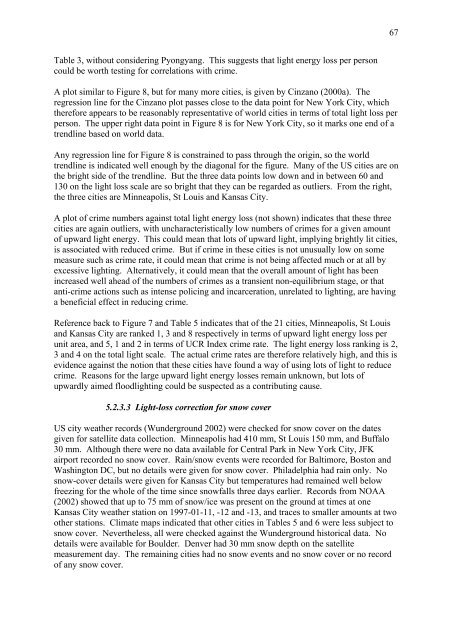Outdoor Lighting and Crime - Amper
Outdoor Lighting and Crime - Amper
Outdoor Lighting and Crime - Amper
You also want an ePaper? Increase the reach of your titles
YUMPU automatically turns print PDFs into web optimized ePapers that Google loves.
Table 3, without considering Pyongyang. This suggests that light energy loss per person<br />
could be worth testing for correlations with crime.<br />
A plot similar to Figure 8, but for many more cities, is given by Cinzano (2000a). The<br />
regression line for the Cinzano plot passes close to the data point for New York City, which<br />
therefore appears to be reasonably representative of world cities in terms of total light loss per<br />
person. The upper right data point in Figure 8 is for New York City, so it marks one end of a<br />
trendline based on world data.<br />
Any regression line for Figure 8 is constrained to pass through the origin, so the world<br />
trendline is indicated well enough by the diagonal for the figure. Many of the US cities are on<br />
the bright side of the trendline. But the three data points low down <strong>and</strong> in between 60 <strong>and</strong><br />
130 on the light loss scale are so bright that they can be regarded as outliers. From the right,<br />
the three cities are Minneapolis, St Louis <strong>and</strong> Kansas City.<br />
A plot of crime numbers against total light energy loss (not shown) indicates that these three<br />
cities are again outliers, with uncharacteristically low numbers of crimes for a given amount<br />
of upward light energy. This could mean that lots of upward light, implying brightly lit cities,<br />
is associated with reduced crime. But if crime in these cities is not unusually low on some<br />
measure such as crime rate, it could mean that crime is not being affected much or at all by<br />
excessive lighting. Alternatively, it could mean that the overall amount of light has been<br />
increased well ahead of the numbers of crimes as a transient non-equilibrium stage, or that<br />
anti-crime actions such as intense policing <strong>and</strong> incarceration, unrelated to lighting, are having<br />
a beneficial effect in reducing crime.<br />
Reference back to Figure 7 <strong>and</strong> Table 5 indicates that of the 21 cities, Minneapolis, St Louis<br />
<strong>and</strong> Kansas City are ranked 1, 3 <strong>and</strong> 8 respectively in terms of upward light energy loss per<br />
unit area, <strong>and</strong> 5, 1 <strong>and</strong> 2 in terms of UCR Index crime rate. The light energy loss ranking is 2,<br />
3 <strong>and</strong> 4 on the total light scale. The actual crime rates are therefore relatively high, <strong>and</strong> this is<br />
evidence against the notion that these cities have found a way of using lots of light to reduce<br />
crime. Reasons for the large upward light energy losses remain unknown, but lots of<br />
upwardly aimed floodlighting could be suspected as a contributing cause.<br />
5.2.3.3 Light-loss correction for snow cover<br />
US city weather records (Wunderground 2002) were checked for snow cover on the dates<br />
given for satellite data collection. Minneapolis had 410 mm, St Louis 150 mm, <strong>and</strong> Buffalo<br />
30 mm. Although there were no data available for Central Park in New York City, JFK<br />
airport recorded no snow cover. Rain/snow events were recorded for Baltimore, Boston <strong>and</strong><br />
Washington DC, but no details were given for snow cover. Philadelphia had rain only. No<br />
snow-cover details were given for Kansas City but temperatures had remained well below<br />
freezing for the whole of the time since snowfalls three days earlier. Records from NOAA<br />
(2002) showed that up to 75 mm of snow/ice was present on the ground at times at one<br />
Kansas City weather station on 1997-01-11, -12 <strong>and</strong> -13, <strong>and</strong> traces to smaller amounts at two<br />
other stations. Climate maps indicated that other cities in Tables 5 <strong>and</strong> 6 were less subject to<br />
snow cover. Nevertheless, all were checked against the Wunderground historical data. No<br />
details were available for Boulder. Denver had 30 mm snow depth on the satellite<br />
measurement day. The remaining cities had no snow events <strong>and</strong> no snow cover or no record<br />
of any snow cover.<br />
67
















